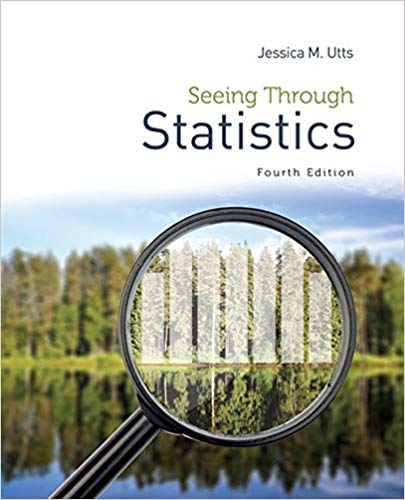Description
Seeing Through Statistics 4th Edition by Jessica M. Utts – Test Bank
CHAPTER 5
experiments and observational studies
SECTION 5.1
defining a common language
FREE RESPONSE QUESTIONS
For Questions 1-3 use the following narrative
Narrative: Toy colors
Suppose a toy company wants to know if certain colors are more appealing and attractive to toddlers than others. They decide to measure this by choosing five colors of blocks and making sets of blocks in each of the five colors. Then they found 30 toddlers to participate in the study, and they randomly assigned each toddler a block color. They observed each toddler separately at the same time of the day, and gave them no other toys to play with. They recorded the length of time each toddler played with the blocks, to see if some colors of blocks were played with longer than other colors. All toddlers in the experiment were the same age (2 years old) and an equal number of girls and boys played with each color of blocks.
- {Toy colors narrative} What is the explanatory variable and what is the response variable?
Answers (RespectivelY): block color and playing time.
- {Toy colors narrative} Is this study an observational study or an experiment?
ANSWER: Experiment
- {Toy colors narrative} Name one confounding variable that was controlled for in this study.
Answer: Any of the following: age; time of day; gender; other toys; interaction with other children. boredom with blocks is also CONTROLLED for because each toddler played with one color.
- Give two reasons why we must sometimes use an observational study instead of an experiment.
Answer: 1) it is unethical or impossible in certain situations to assign people to receive a specific treatment (such as smoking); 2) certain explanatory variables, such as left vs. right handedness, are inherent traits and cannot be randomly assigned.
Multiple Choice QUESTIONS
- Which of the following describes an experiment?
- Create differences in the explanatory variable and then examine the results.
- Observe differences in the explanatory variable and then notice whether these are related to differences in the response variable.
- Both a) and b) are experiments.
- Neither a) nor b) are experiments
Answer: a
- Which of the following is a property of a confounding variable?
- It is related to the explanatory variable; individuals who differ on the explanatory variable are also likely to differ on the confounding variable.
- It affects the response variable.
- Its effect on the response variable cannot be separated from the effect of the explanatory variable on the response variable.
- All of the above
Answer: d
- What is the effect of recruiting volunteers to participate in a randomized experiment?
- The results will be more credible because people who really wanted to participate took part in the study.
- The results cannot necessarily be extended to the larger population.
- There will be no effect because the people are always randomly assigned to treatments, eliminating any type of bias.
- Researchers are never allowed to use volunteers to participate in an experiment.
Answer: b
- What does randomization mean in terms of experiments?
- Each of the experimental units is randomly selected to participate.
- Each of the experimental units is randomly assigned to a treatment.
- The researchers randomly select which treatments they will include in the experiment.
- None of the above.
Answer: b
fILL-in-the-blank QUESTIONS
- A(n) __________ variable is one that attempts to explain or is purported to cause (at least partially) differences in a(n) __________ variable.
Answers (respectively): explanatory; outcome (or response)
- One of the major advantages of an experiment over an observational study is that in an experiment, the researcher attempts to control for __________ variables.
Answer: confounding
SECTION 5.2
Designing a good experiment
FREE RESPONSE QUESTIONS
- What is one advantage of using a matched-pairs design in a randomized experiment?
Answer: each person in the study serves as his/her own control; natural variability in the response variable from person to person doesn’t obscure the effects of the treatment.
For Questions 12-13 use the following narrative
Narrative: BMD
A recent magazine article stated that bone mineral density (BMD) may one day predict breast cancer risk in older women, according to a study in the Journal of the National Cancer Institute. Researchers followed the health of 8,905 women who were 65 or older and initially cancer free. Eventually 315 participants developed breast cancer. Women with the highest BMD were almost three times more likely to develop breast cancer, compared to the women with low BMD. (Better Homes and Gardens, October 2001, page 224.)
- {BMD Narrative} Do the results of this study mean that a high bone mineral density (BMD) causes breast cancer in older women? Explain your answer.
Answer: No; it is just predictive at this point. this was an observational study, and there could be many confounding variables.
- {BMD Narrative} Explain why it is not possible to conduct a randomized experiment in this situation.
Answer: it is not possible to randomly assign women to either a low or high bmd; it would also be unethical to forcibly create a high bmd for a group of women and see if this increases their chances of developing breast cancer.
- Using 20 pairs of identical twins to participate in a study containing a treatment and a control is an example of what type of experimental design?
Answer: matched-pairs

Reviews
There are no reviews yet.